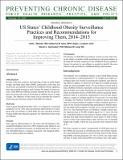| dc.contributor.author | Blondin, Kelly J. | en_US |
| dc.contributor.author | Giles, Catherine M. | en_US |
| dc.contributor.author | Cradock, Angie L. | en_US |
| dc.contributor.author | Gortmaker, Steven L. | en_US |
| dc.contributor.author | Long, Michael W. | en_US |
| dc.date.accessioned | 2016-10-11T20:28:54Z | |
| dc.date.issued | 2016 | en_US |
| dc.identifier.citation | Blondin, Kelly J., Catherine M. Giles, Angie L. Cradock, Steven L. Gortmaker, and Michael W. Long. 2016. “US States’ Childhood Obesity Surveillance Practices and Recommendations for Improving Them, 2014–2015.” Preventing Chronic Disease 13 (1): E97. doi:10.5888/pcd13.160060. http://dx.doi.org/10.5888/pcd13.160060. | en |
| dc.identifier.issn | 1545-1151 | en |
| dc.identifier.uri | http://nrs.harvard.edu/urn-3:HUL.InstRepos:29002714 | |
| dc.description.abstract | Introduction: Routine collection, analysis, and reporting of data on child height, weight, and body mass index (BMI), particularly at the state and local levels, are needed to monitor the childhood obesity epidemic, plan intervention strategies, and evaluate the impact of interventions. Child BMI surveillance systems operated by the US government do not provide state or local data on children across a range of ages. The objective of this study was to describe the extent to which state governments conduct child BMI surveillance. Methods: From August through December 2014, we conducted a structured telephone survey with state government administrators to learn about state surveillance of child BMI. We also searched websites of state health and education agencies for information about state surveillance. Results: State agency administrators in 48 states and Washington, DC, completed telephone interviews (96% response rate). Based on our interviews and Internet research, we determined that 14 states collect child BMI data in a manner consistent with standard definitions of public health surveillance. Conclusion: The absence of child BMI surveillance systems in most states limits the ability of public health practitioners and policymakers to develop and evaluate responses to the childhood obesity epidemic. Greater investment in surveillance is needed to identify the most effective and cost-effective childhood obesity interventions. | en |
| dc.language.iso | en_US | en |
| dc.publisher | Centers for Disease Control and Prevention | en |
| dc.relation.isversionof | doi:10.5888/pcd13.160060 | en |
| dc.relation.hasversion | http://www.ncbi.nlm.nih.gov/pmc/articles/PMC4975176/pdf/ | en |
| dash.license | LAA | en_US |
| dc.title | US States’ Childhood Obesity Surveillance Practices and Recommendations for Improving Them, 2014–2015 | en |
| dc.type | Journal Article | en_US |
| dc.description.version | Version of Record | en |
| dc.relation.journal | Preventing Chronic Disease | en |
| dash.depositing.author | Giles, Catherine M. | en_US |
| dc.date.available | 2016-10-11T20:28:54Z | |
| dc.identifier.doi | 10.5888/pcd13.160060 | * |
| dash.contributor.affiliated | Long, Michael | |
| dash.contributor.affiliated | Giles, Catherine | |
| dash.contributor.affiliated | Cradock, Angie | |
| dash.contributor.affiliated | Gortmaker, Steven | |


